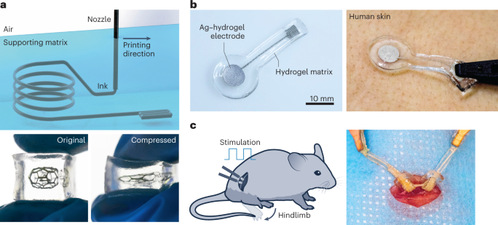Hydrogel-based electronic devices are ideal candidates for creating human–machine interfaces due to their softness, stretchability and biocompatibility. However, such devices still require the development of appropriate manufacturing processes and material selection. Recently, Dr Shaoxing Qu, Professor of Engineering Mechanics, Zhejiang University commented on a recent publication on three-dimensional(3D) printing of soft hydrogel electronics, to share his thoughts with readers of Nature Electronics.
Professor Qu summarized that existing printing methods encounter challenges when trying to manufacture integrated devices that require multi-material printing and interfacial bonding between heterogeneous materials, and conventional printable conductive materials, such as ionic conductors and organic conductors like poly (3,4-ethylene dioxythiophene) polystyrene sulfonate, have relatively low conductivity, which can limit device performance.
The newly published work printed soft hydrogel devices consisting of stretchy 3D circuits embedded within a supporting alginate–polyacrylamide hydrogel matrix. The matrix hydrogel must meet strict rheological requirements to allow the embedded 3D printing. Specifically, the matrix hydrogel is a double network containing both physical and chemical networks, but instead of a simultaneous ‘one-pot’ synthesis of both, they can be formed at separate stages. Professor Qu believed that the work provided a suitable manufacturing strategy for integrated hydrogel electronics by avoiding complex manufacturing processes and offering freedom in the design of versatile hydrogel devices. He further pointed out that the conductivity of the silver–hydrogel ink is still several orders of magnitude lower than conventional metals, and the electrical stability of the current hydrogel electronics remains a challenging problem. Thus, future research should focus on the development of stretchable conductive materials.

To learn more about Professor Qu’s thoughts, please visit https://www.nature.com/articles/s41928-022-00900-0.
About Professor Qu
Dr. Shaoxing Qu is a Changjiang Chair Professor (from Ministry of Education, China) and Distinguished Young Scholar grant from National Natural Science Foundation of China. He serves as the Director of the Key Laboratory of Soft Machines and Smart Devices of Zhejiang Province.
He got his bachelor degree from University of Science and Technology of China in1997, Master of Engineering from Tsinghua University in 2000, and Ph.D. from UIUC in 2004. After spending two years at Brown University as postdoc, he joined Zhejiang University in 2006 and was promoted to full professor in 2011. He has published more than 180 journal papers.
Dr. Qu’s primary research interests include soft materials and soft machines, insect-scalerobots, mechanics of composites, and micro/nano mechanics.
About SIAS
Shanghai Institute for Advanced Study of Zhejiang University (SIAS) is a jointly launched new institution of research and development by Shanghai Municipal Government and Zhejiang University in June, 2020. The platform represents an intersection of technology and economic development, serving as a market leading trail blazer to cultivate a novel community for innovation amongst enterprises.
SIAS is seeking top talents working on the frontiers of computational sciences who can envision and actualize a research program that will bring out new solutions to areas include, but not limited to, Artificial Intelligence, Computational Biology, Computational Engineering and Fintech.

